
In December 2011, President Barack Obama proclaimed January, National Slavery and Human Trafficking Prevention Month. His proclamation read in part:
Nearly a century and a half ago, President Abraham Lincoln issued the Emancipation Proclamation — a document that reaffirmed the noble goals of equality and freedom for all that lie at the heart of what it means to live in America….Yet, despite our successes, thousands of individuals living in the United States and still more abroad suffer in silence under the intolerable yoke of modern slavery. During National Slavery and Human Trafficking Prevention Month, we stand with all those who are held in compelled service; we recognize the people, organizations, and government entities that are working to combat human trafficking; and we recommit to bringing an end to this inexcusable human rights abuse. Human trafficking endangers the lives of millions of people around the world, and it is a crime that knows no borders….I urge all Americans to educate themselves about all forms of modern slavery and the signs and consequences of human trafficking. Together, and in cooperation with our partners around the world, we can work to end this terrible injustice and protect the rights to life and liberty entrusted to us by our forebears and owed to our children.
What is Human Trafficking?
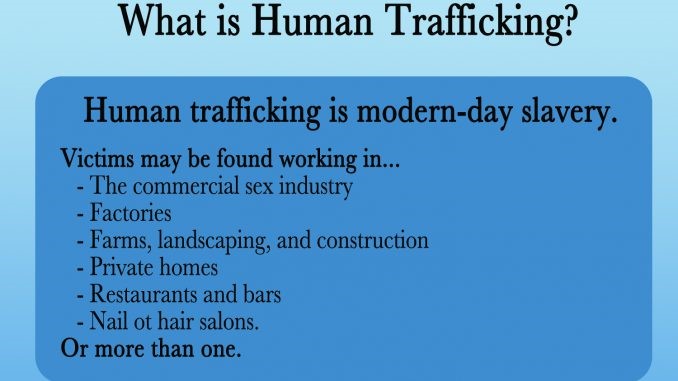
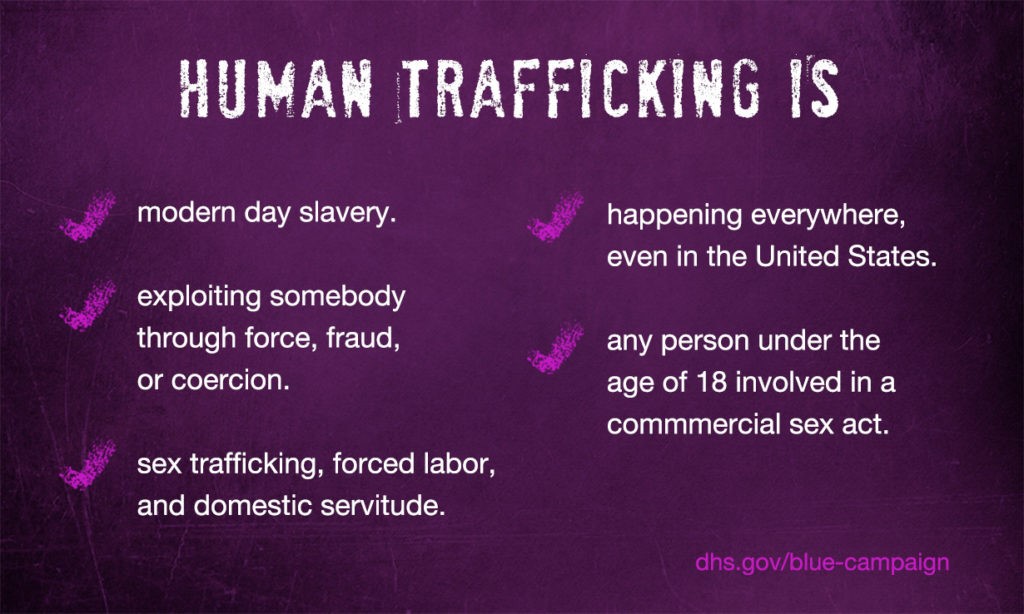
The Department of Homeland Security states: “It can happen in any community and victims can be any age, race, gender, or nationality. Traffickers might use violence, manipulation, or false promises of well-paying jobs or romantic relationships to lure victims into trafficking situations. Language barriers, fear of their traffickers, and/or fear of law enforcement frequently keep victims from seeking help, making human trafficking a hidden crime.” [“What is Human Trafficking?” https://www.dhs.gov/blue-campaign/what-human-trafficking]. Click on this link for the department’s video, “What Is Human Trafficking?” https://youtu.be/35uM5VMrZas.
Human Trafficking is a $150 Billion Criminal Business
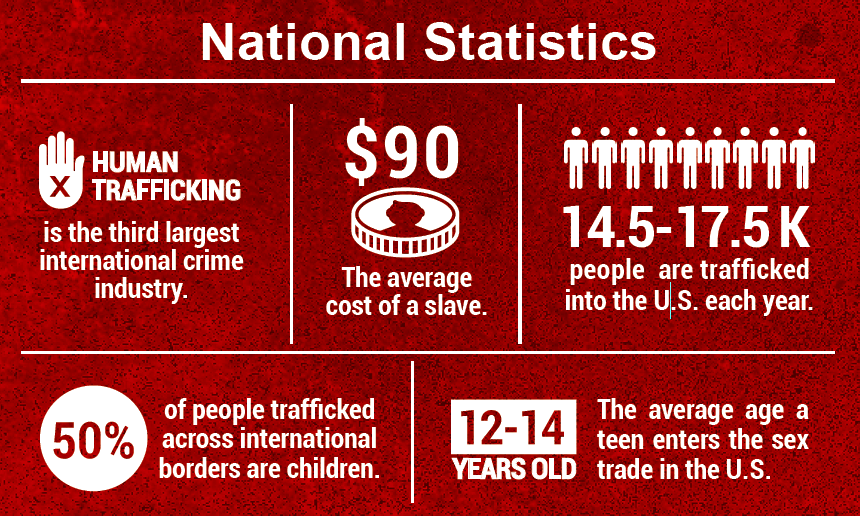
Types of Human Trafficking
The most common types of human trafficking are sexual exploitation and forced labor as depicted in these videos: https://youtu.be/sOHq0MlN3PY
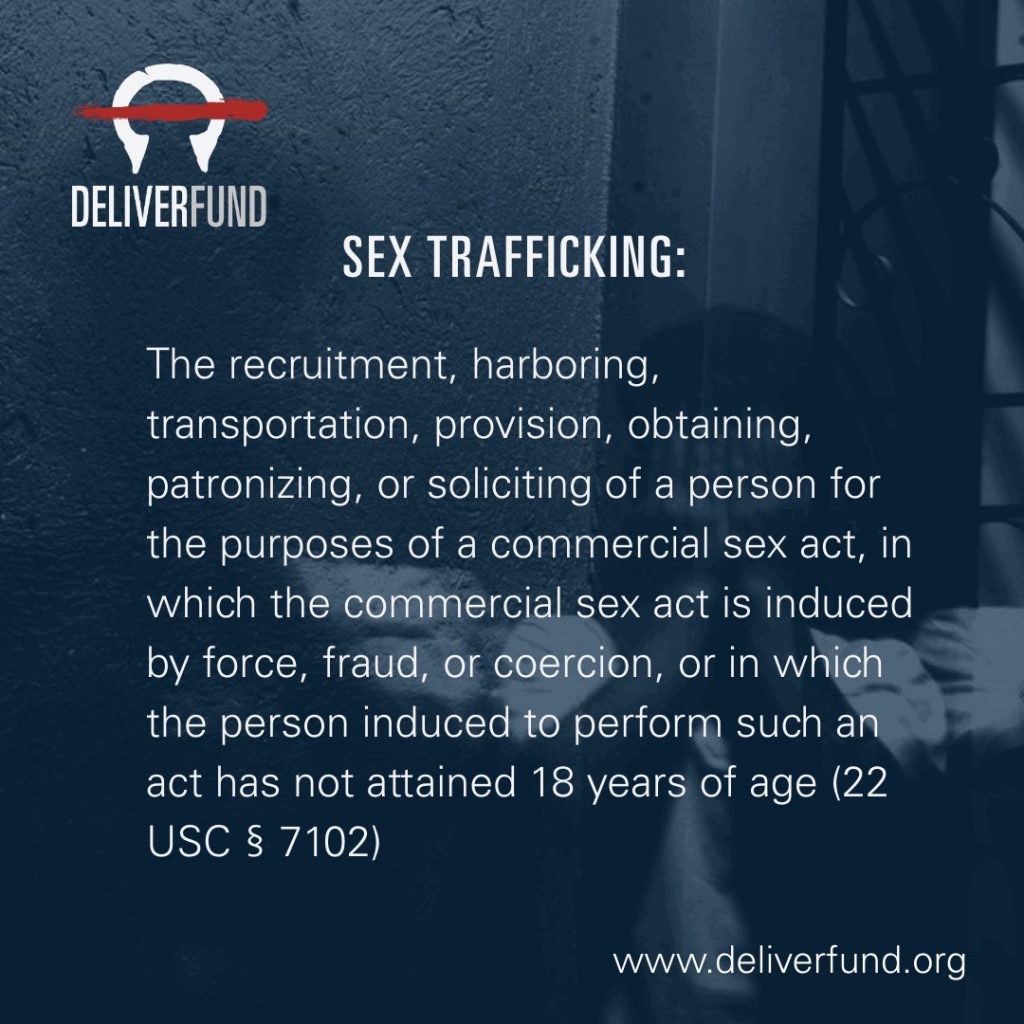
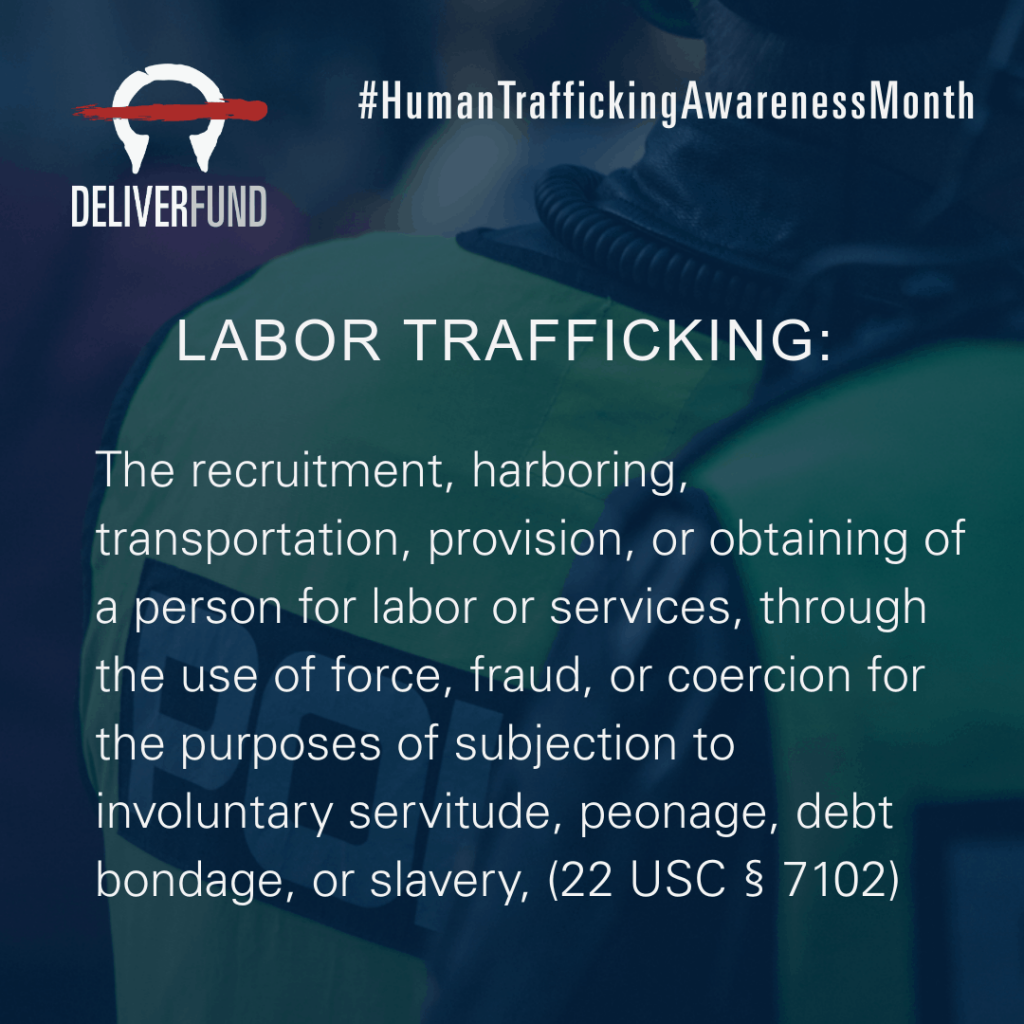
https://YouTube/h3dCPWPKZgg
Other forms include “domestic servitude and forced marriage; organ removal; and the exploitation of children in begging, the sex trade and warfare.” [“7 facts about human trafficking you may not know, plus 3 ways you can help.” https://www.crs.org/stories/stop-human-trafficking]
Watch https://youtu.be/sOHq0MlN3PY to learn more.
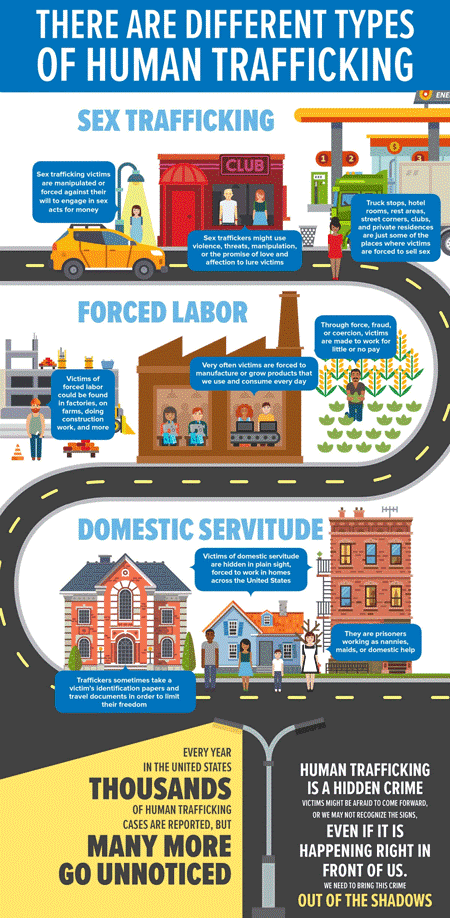
Who Are the Victims?
Human trafficking affects EVERYONE – women, men, children, youth, those foreign to a nation and a country’s own citizens. Over half of the victims are female.
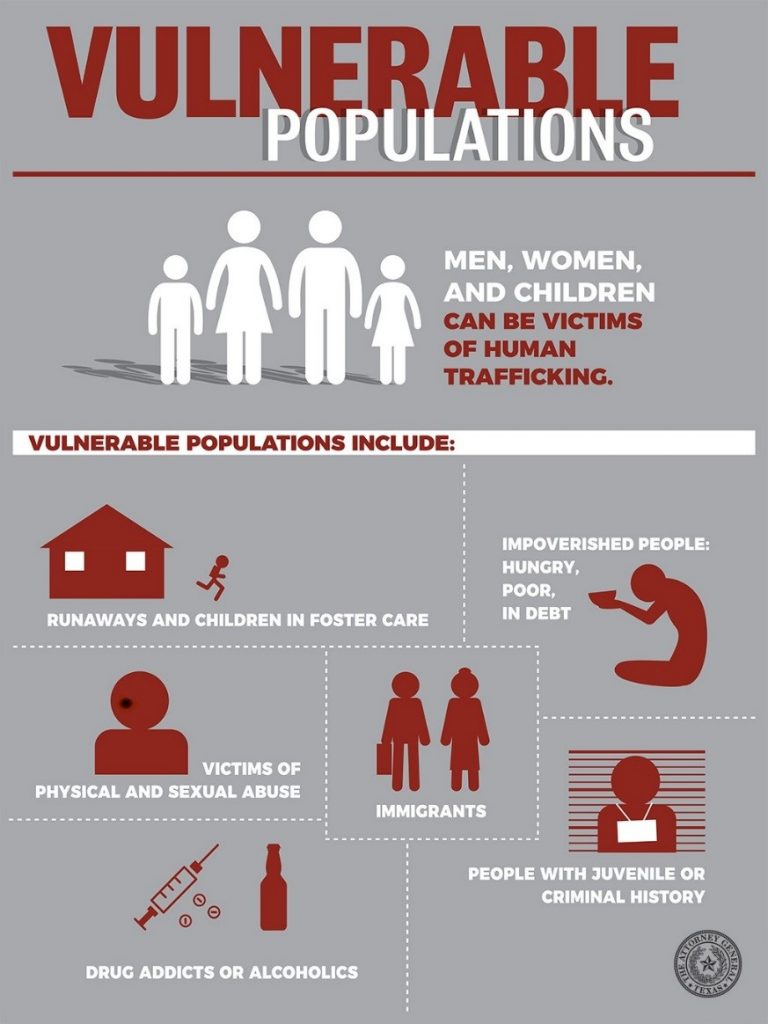
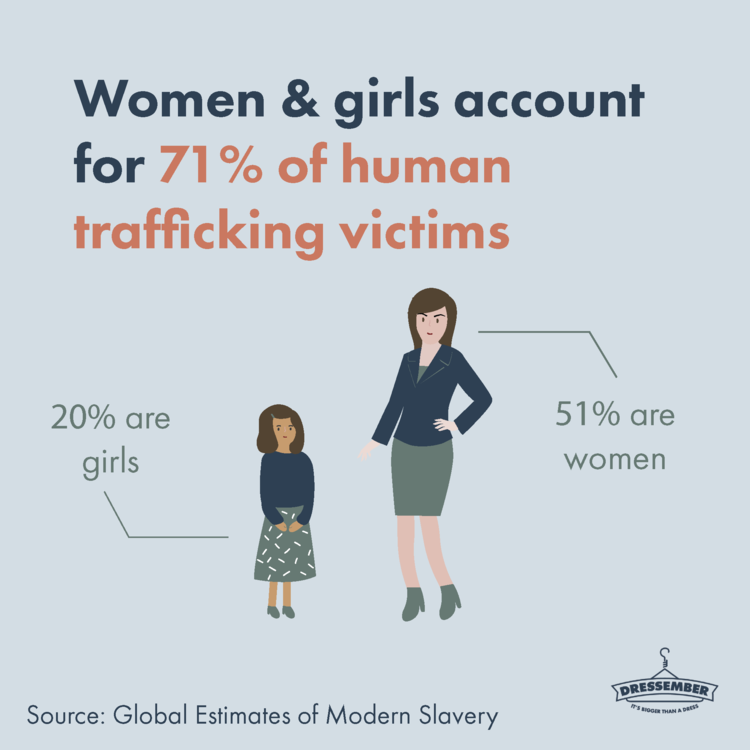
Signs of Human Trafficking
The Department of Homeland Defense has a list of indicators. “Recognizing key indicators of human trafficking is the first step in identifying victims and can help save a life.”
- Does the person appear disconnected from family, friends, community organizations, or houses of worship?
- Has a child stopped attending school?
- Has the person had a sudden or dramatic change in behavior?
- Is a juvenile engaged in commercial sex acts?
- Is the person disoriented or confused, or showing signs of mental or physical abuse?
- Does the person have bruises in various stages of healing?
- Is the person fearful, timid, or submissive?
- Does the person show signs of having been denied food, water, sleep, or medical care?
- Is the person often in the company of someone to whom he or she defers? Or someone who seems to be in control of the situation, e.g., where they go or who they talk to?
- Does the person appear to be coached on what to say?
- Is the person living in unsuitable conditions?
- Does the person lack personal possessions and appear not to have a stable living situation?
- Does the person have freedom of movement? Can the person freely leave where they live? Are there unreasonable security measures?
“Not all indicators listed above are present in every human trafficking situation, and the presence or absence of any of the indicators is not necessarily proof of human trafficking.” The department also has a Blue Campaign indicator card, which can be downloaded or ordered. [“Indicators of Human Traffacking,” https://www.dhs.gov/blue-campaign/indicators-human-trafficking]
Blue Campaign’s public service announcement shows a labor trafficking scenario happening in a typical neighborhood. https://www.dhs.gov/blue-campaign/neighborhood-watch?utm_source=bluecampaign_slideshow&utm_medium=web&utm_campaign=dhsgov
How are People Trafficked?
Females are trafficked in various ways including “pimp-controlled trafficking, in which a single person controls the victim physically, psychologically, or emotionally; gang trafficking, in which a victim is controlled by more than one person, and may be abused by the gang members or prostituted out by the gang; survival sex, where the victim feels they are not able to escape and must perform sex acts in order to survive; familial trafficking, in which the victim is abused and controlled by their family members; and forced marriages.” (At times males are used in sex trafficking, but more frequently they are trafficked in labor markets.) [“Facts about Human Trafficking in the US,” https://deliverfund.org/2020/04/17/facts-about-human-trafficking-in-the-us/?gclid=CjwKCAiAudD_BRBXEiwAudakXxmLElALcNcBvjjBLXWOFgowViyEVubBJd_JxBIvvwEGmWfP5tJMUBoCYhAQAvD_BwE
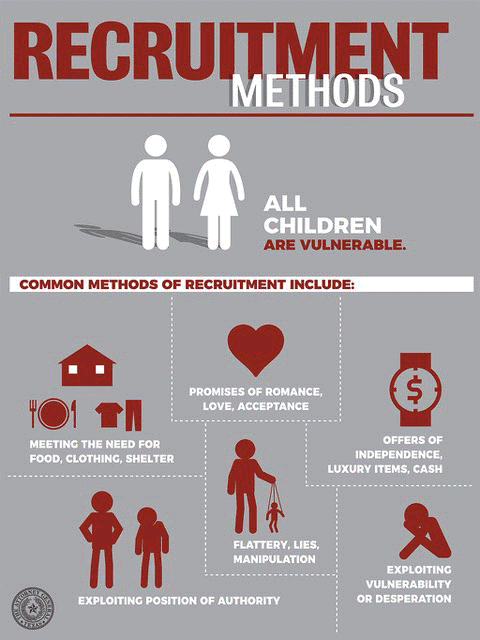
Signs of Human Trafficking
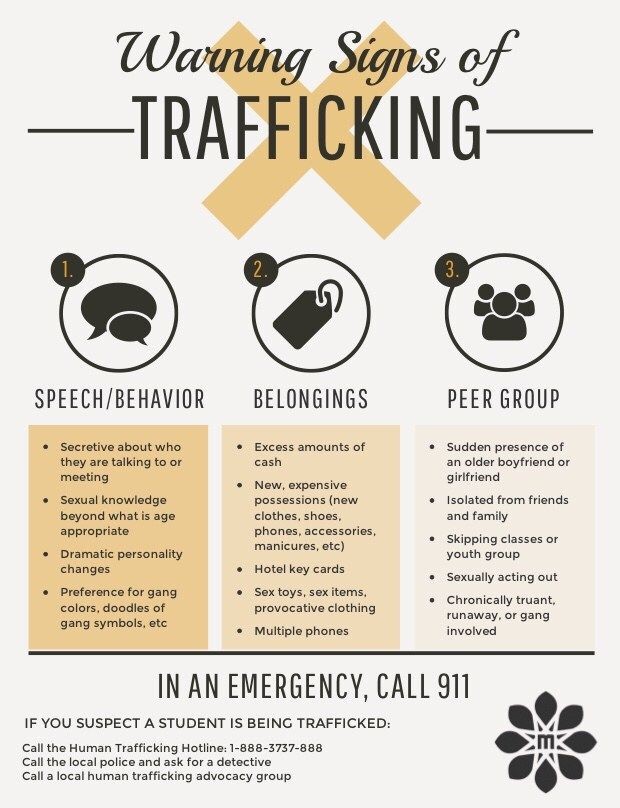
The Department of Homeland Defense has a list of indicators. “Recognizing key indicators of human trafficking is the first step in identifying victims and can help save a life.”
- Does the person appear disconnected from family, friends, community organizations, or houses of worship?
- Has a child stopped attending school?
- Has the person had a sudden or dramatic change in behavior?
- Is a juvenile engaged in commercial sex acts?
- Is the person disoriented or confused, or showing signs of mental or physical abuse?
- Does the person have bruises in various stages of healing?
- Is the person fearful, timid, or submissive?
- Does the person show signs of having been denied food, water, sleep, or medical care?
- Is the person often in the company of someone to whom he or she defers? Or someone who seems to be in control of the situation, e.g., where they go or who they talk to?
- Does the person appear to be coached on what to say?
- Is the person living in unsuitable conditions?
- Does the person lack personal possessions and appear not to have a stable living situation?
- Does the person have freedom of movement? Can the person freely leave where they live? Are there unreasonable security measures?
“Not all indicators listed above are present in every human trafficking situation, and the presence or absence of any of the indicators is not necessarily proof of human trafficking.” The department also has a Blue Campaign indicator card, which can be downloaded or ordered. [“Indicators of Human Trafficking,” https://www.dhs.gov/blue-campaign/indicators-human-trafficking]
Blue Campaign’s public service announcement shows a labor trafficking scenario happening in a typical neighborhood. https://www.dhs.gov/blue-campaign/neighborhood-watch?utm_source=bluecampaign_slideshow&utm_medium=web&utm_campaign=dhsgov
Stay Tuned for Part II